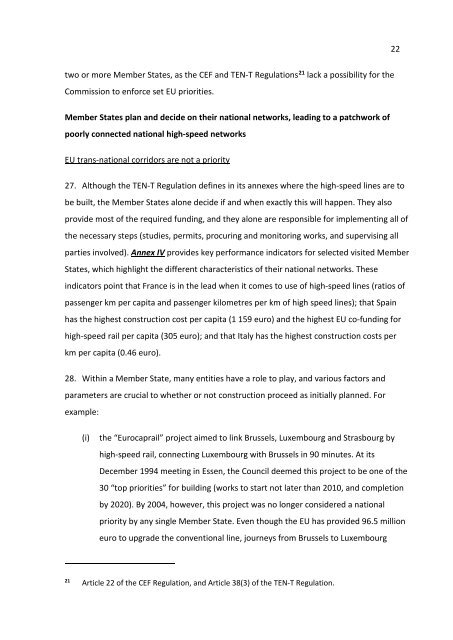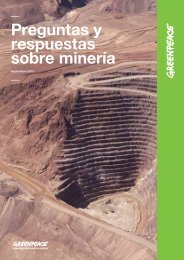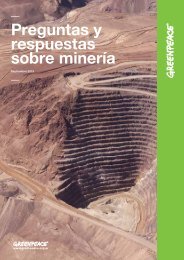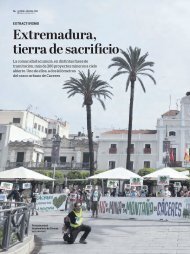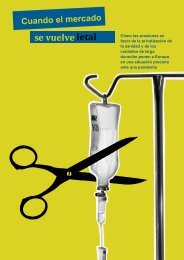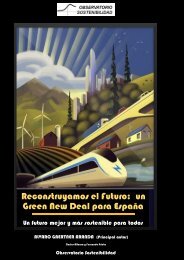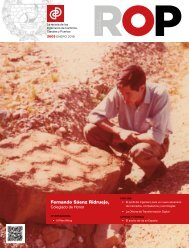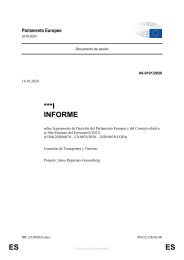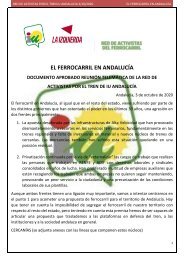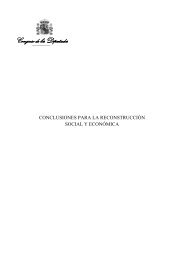La Red de Alta Velocidad Europea: Más un mosaico poco efectivo que una realidad
El presente comunicado de prensa tiene por objeto ofrecer una síntesis del contenido esencial del informe especial del Tribunal de Cuentas Europeo. El texto íntegro del informe puede consultarse en www.eca.europa.eu.
El presente comunicado de prensa tiene por objeto ofrecer una síntesis del contenido esencial del informe especial del
Tribunal de Cuentas Europeo.
El texto íntegro del informe puede consultarse en www.eca.europa.eu.
You also want an ePaper? Increase the reach of your titles
YUMPU automatically turns print PDFs into web optimized ePapers that Google loves.
22<br />
two or more Member States, as the CEF and TEN-T Regulations 21 lack a possibility for the<br />
Commission to enforce set EU priorities.<br />
Member States plan and <strong>de</strong>ci<strong>de</strong> on their national networks, leading to a patchwork of<br />
poorly connected national high-speed networks<br />
EU trans-national corridors are not a priority<br />
27. Although the TEN-T Regulation <strong>de</strong>fines in its annexes where the high-speed lines are to<br />
be built, the Member States alone <strong>de</strong>ci<strong>de</strong> if and when exactly this will happen. They also<br />
provi<strong>de</strong> most of the required f<strong>un</strong>ding, and they alone are responsible for implementing all of<br />
the necessary steps (studies, permits, procuring and monitoring works, and supervising all<br />
parties involved). Annex IV provi<strong>de</strong>s key performance indicators for selected visited Member<br />
States, which highlight the different characteristics of their national networks. These<br />
indicators point that France is in the lead when it comes to use of high-speed lines (ratios of<br />
passenger km per capita and passenger kilometres per km of high speed lines); that Spain<br />
has the highest construction cost per capita (1 159 euro) and the highest EU co-f<strong>un</strong>ding for<br />
high-speed rail per capita (305 euro); and that Italy has the highest construction costs per<br />
km per capita (0.46 euro).<br />
28. Within a Member State, many entities have a role to play, and various factors and<br />
parameters are crucial to whether or not construction proceed as initially planned. For<br />
example:<br />
(i)<br />
the “Eurocaprail” project aimed to link Brussels, Luxembourg and Strasbourg by<br />
high-speed rail, connecting Luxembourg with Brussels in 90 minutes. At its<br />
December 1994 meeting in Essen, the Co<strong>un</strong>cil <strong>de</strong>emed this project to be one of the<br />
30 “top priorities” for building (works to start not later than 2010, and completion<br />
by 2020). By 2004, however, this project was no longer consi<strong>de</strong>red a national<br />
priority by any single Member State. Even though the EU has provi<strong>de</strong>d 96.5 million<br />
euro to upgra<strong>de</strong> the conventional line, journeys from Brussels to Luxembourg<br />
21<br />
Article 22 of the CEF Regulation, and Article 38(3) of the TEN-T Regulation.


